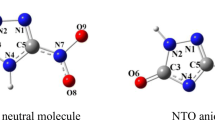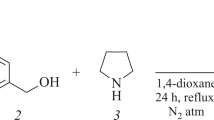Abstract
Combining computer chemistry calculation with experimental verification is useful both in proving concepts and what is chemically possible. Computational predictions, using MOPAC quantum mechanical and classical force field mechanics, were used to investigate most likely first-tier intermediates of cyclic and cage cyclic nitramines—comparing bond lengths and angles, heats of formation, steric energy, dipole moments, solvent accessibility and electrostatic potential surfaces, partial charges, and Highest Occupied Molecular Orbitals/Lowest Unoccupied Molecular Orbitals (HOMO/LUMO) energies. Two competing modes of degradation are summarized: through addition of hydroxide ions and through addition of photo-induced free radicals. UV/VIS measured concentrations and followed the course of reactions. FTIR followed CL-20 degradation through alkali hydrolysis, where FTIR measurements verified theoretical predictions.
Similar content being viewed by others
REFERENCES
Chan, M.; Boggs, T. Advanced CL-20 Based Propellant Formu-lated by China Lake Team. Mil/techtransfer/cradas/cl20pap.htm, 02/07/2001.
Balakrishnan, V.; Halasz, A.; Hawari, J. Environ. Sci. Technol. 2003, 37,1838–1843.
Qasim, M.; Fredrickson, H.; McGrath, C.; Bajpai, R. Modes of degradation of cyclic nitramines: An approximation methods com-parison of the relationships between the structures and reactivities of CL-20, ONC, TNTAC, and RDX. Presented at the 11th Conf. Curr. Trends Comp. Chem., Jackson, MS, 2002.
Sorescu, D.; Rice, B.; Thompson, D. J. Phys. Chem. B 1998, 102,948–952.
Hawari, J. In Biodegradation of Nitroaromatic Compounds and Ex-plosives;Spain, J. C.; Hughes, J. B.; Knackmuss, H., Eds.; Lewis Publisher: Boca Raton, FL, 2000.
Politzer, P.; Murray, J. S.; Seminario, J. M.; Lane, P.; Grice, M. E.; Concha, M. C. J. Mol. Struct. (Theochem.) 2001, 573,1–10.
Hansen, L. D.; Larson, S. L.; Felt, D. R.; Qasim, M.; Cullinane, M. J. Based-catalyzed transformations of explosive compounds in soil & water. USACE Env. Dev. Workshop, Portland, OR, 2001.
Stewart, J. J. P. MOPAC 2002 Manual. Fujitsu Limited, 2001.
Qasim, M.; Fredrickson, H.; McGrath, C.; Furey, J.; Bajpai, R. J. Struct. Chem. submitted for publication.
Author information
Authors and Affiliations
Rights and permissions
About this article
Cite this article
Qasim, M.M., Fredrickson, H.L., McGrath, C. et al. Semiempirical Predictions of Chemical Degradation Reaction Mechanisms of CL-20 as Related to Molecular Structure. Structural Chemistry 15, 493–499 (2004). https://doi.org/10.1023/B:STUC.0000037907.27898.f5
Issue Date:
DOI: https://doi.org/10.1023/B:STUC.0000037907.27898.f5




